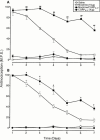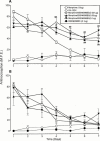Blockade and reversal of spinal morphine tolerance by peptide and non-peptide calcitonin gene-related peptide receptor antagonists
- PMID: 11053206
- PMCID: PMC1572412
- DOI: 10.1038/sj.bjp.0703655
Blockade and reversal of spinal morphine tolerance by peptide and non-peptide calcitonin gene-related peptide receptor antagonists
Abstract
This study examined the effects of the peptide CGRP receptor antagonist CGRP(8-37) and the newly-developed non-peptide CGRP receptor antagonist BIBN4096BS for their potential to both inhibit the development and reverse tolerance to the antinociceptive action of morphine. Repeated administration of intrathecal morphine (15 microg), once daily, produced a progressive decline of antinociceptive effect and an increase in the ED(50) value in the tailflick and paw pressure tests. Co-administration of CGRP(8-37) (4 microg) or BIBN4096BS (0.05, 0.1 microg) with morphine (15 microg) prevented the decline of antinociceptive effect and increase in ED(50) value in the tailflick test. Intrathecal administration of the CGRP receptor antagonists did not alter the baseline responses in either tests. Acute CGRP(8-37) also did not potentiate the acute actions of spinal morphine. In animals rendered tolerant to intrathecal morphine, subsequent administration of CGRP(8-37) (4 microg) with morphine (15 microg) partially restored the antinociceptive effect and ED(50) value of acute morphine, reflecting the reversal of tolerance. Animals tolerant to intrathecal morphine expressed increased CGRP and substance P-like immunostaining in the dorsal horn of the spinal cord. The increase in CGRP, but not substance P-like immunostaining, was blocked by a co-treatment with CGRP(8-37) (4 microg). In animals already tolerant to morphine, the increase in CGRP but not substance P-like immunostaining was partially reversed by CGRP(8-37) (4 microg). These data suggest that activation of spinal CGRP receptors contributes to both the development and expression of spinal opioid tolerance. CGRP receptor antagonists may represent a useful therapeutic approach for preventing as well as reversing opioid tolerance.
Figures







Similar articles
-
Inhibition of neurokinin-1-substance P receptor and prostanoid activity prevents and reverses the development of morphine tolerance in vivo and the morphine-induced increase in CGRP expression in cultured dorsal root ganglion neurons.Eur J Neurosci. 2003 Sep;18(6):1572-83. doi: 10.1046/j.1460-9568.2003.02887.x. Eur J Neurosci. 2003. PMID: 14511336
-
A calcitonin gene-related peptide receptor antagonist prevents the development of tolerance to spinal morphine analgesia.J Neurosci. 1996 Apr 1;16(7):2342-51. doi: 10.1523/JNEUROSCI.16-07-02342.1996. J Neurosci. 1996. PMID: 8601814 Free PMC article.
-
Morphological evidence for the involvement of microglial p38 activation in CGRP-associated development of morphine antinociceptive tolerance.Peptides. 2010 Dec;31(12):2179-84. doi: 10.1016/j.peptides.2010.08.020. Epub 2010 Sep 8. Peptides. 2010. PMID: 20804799
-
Development and potential of non-peptide antagonists for calcitonin-gene-related peptide (CGRP) receptors: evidence for CGRP receptor heterogeneity.Biochem Soc Trans. 2002 Aug;30(4):468-73. doi: 10.1042/bst0300468. Biochem Soc Trans. 2002. PMID: 12196117 Review.
-
[Involvement of adrenomedullin in the pathogenesis of inflammatory pain and morphine tolerance].Sheng Li Xue Bao. 2015 Aug 25;67(4):431-6. Sheng Li Xue Bao. 2015. PMID: 26300256 Review. Chinese.
Cited by
-
Effects of Electroacupuncture Treatment on Bone Cancer Pain Model with Morphine Tolerance.Evid Based Complement Alternat Med. 2016;2016:8028474. doi: 10.1155/2016/8028474. Epub 2016 Sep 8. Evid Based Complement Alternat Med. 2016. PMID: 27672401 Free PMC article.
-
Pathophysiology of Migraine: A Disorder of Sensory Processing.Physiol Rev. 2017 Apr;97(2):553-622. doi: 10.1152/physrev.00034.2015. Physiol Rev. 2017. PMID: 28179394 Free PMC article. Review.
-
Role of protein kinase C and mu-opioid receptor (MOPr) desensitization in tolerance to morphine in rat locus coeruleus neurons.Eur J Neurosci. 2009 Jan;29(2):307-18. doi: 10.1111/j.1460-9568.2008.06573.x. Eur J Neurosci. 2009. PMID: 19200236 Free PMC article.
-
The role of spinal neuropeptides and prostaglandins in opioid physical dependence.Br J Pharmacol. 2002 May;136(1):37-48. doi: 10.1038/sj.bjp.0704681. Br J Pharmacol. 2002. PMID: 11976266 Free PMC article.
-
Nuclear localization of SP, CGRP, and NK1R in a subpopulation of dorsal root ganglia subpopulation cells in rats.Cell Mol Neurobiol. 2006 Mar;26(2):191-207. doi: 10.1007/s10571-006-9020-5. Epub 2006 May 6. Cell Mol Neurobiol. 2006. PMID: 16763782 Free PMC article.
References
-
- COX B.M.Molecular and cellular mechanisms in opioid tolerance Towards a New Pharmacotherapy of Pain 1999John Wiley, Chichester, UK; 137–156.eds. Bausbaum A.I. & Besson J.M. pp
-
- D'AMOUR F.E., SMITH D.L. A method for determining loss of pain sensation. J. Pharmacol. Exp. Ther. 1941;72:74–79.
-
- DENNIS T., FOURNIER A., CADIEUX A., POMERLEAU F., JOLICOEUR F.B., , ST, QUIRION R. hCGRP8-37, a calcitonin gene-related peptide antagonist revealing calcitonin gene-related peptide receptor heterogeneity in brain and periphery. J. Pharmacol. Exp. Ther. 1990;254:123–128. - PubMed
-
- DICKENSON A.H., SULLIVAN A.F. Electrophysiological studies on the effects of intrathecal morphine on nociceptive neurones in the rat dorsal horn. Pain. 1986;24:211–222. - PubMed
Publication types
MeSH terms
Substances
LinkOut - more resources
Full Text Sources
Other Literature Sources
Research Materials

